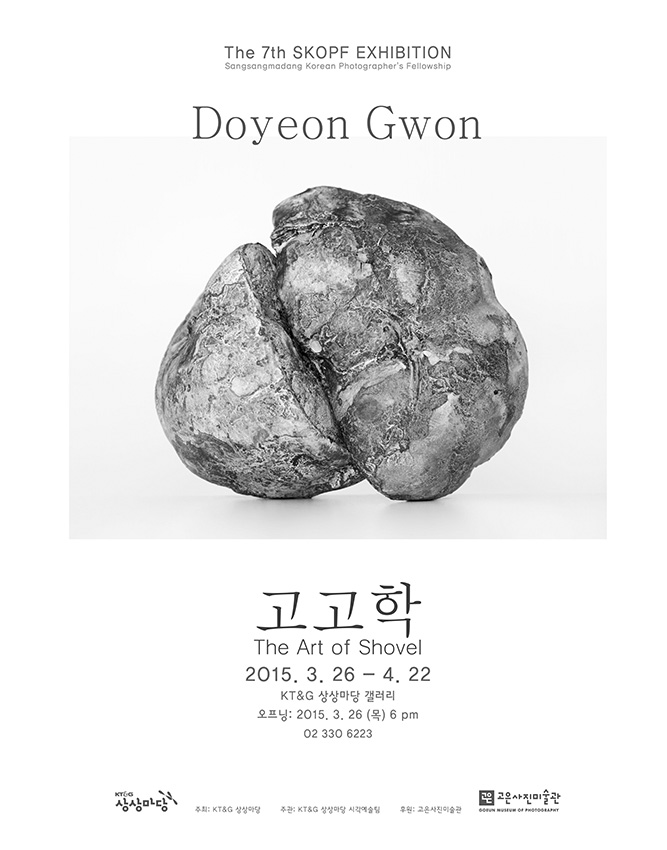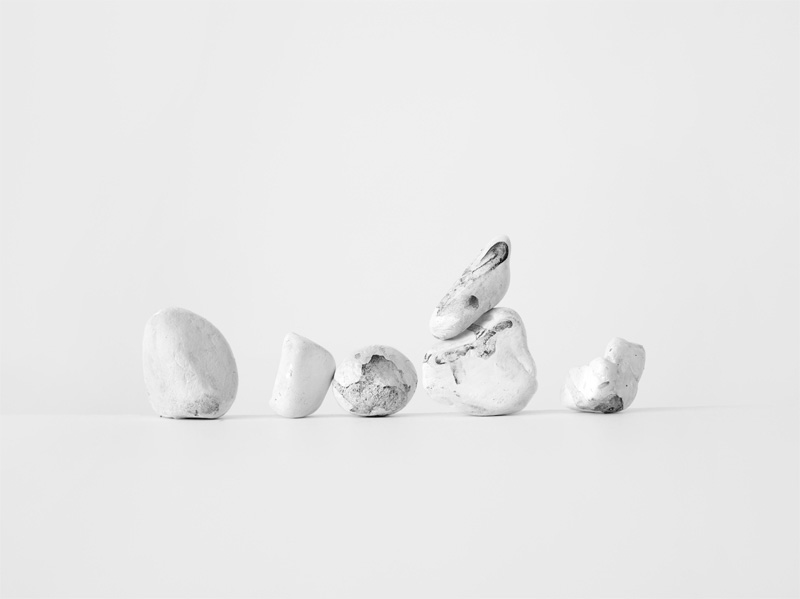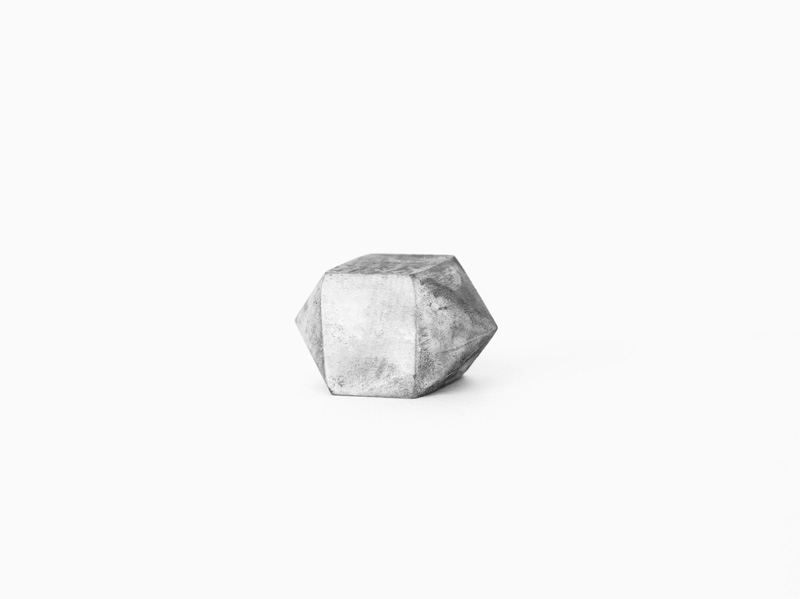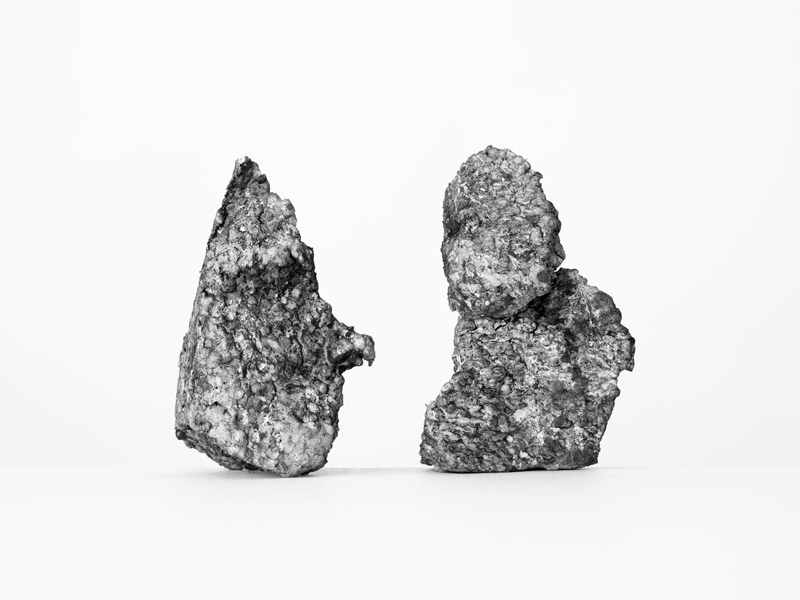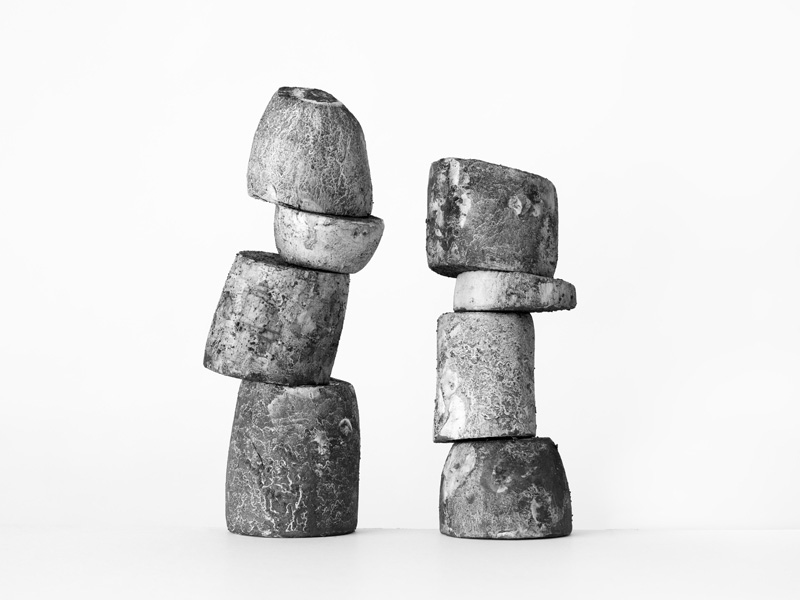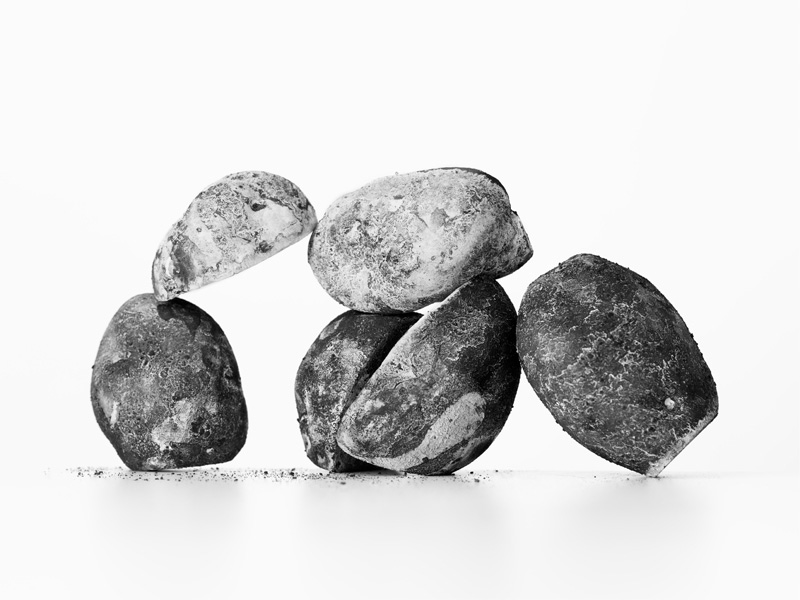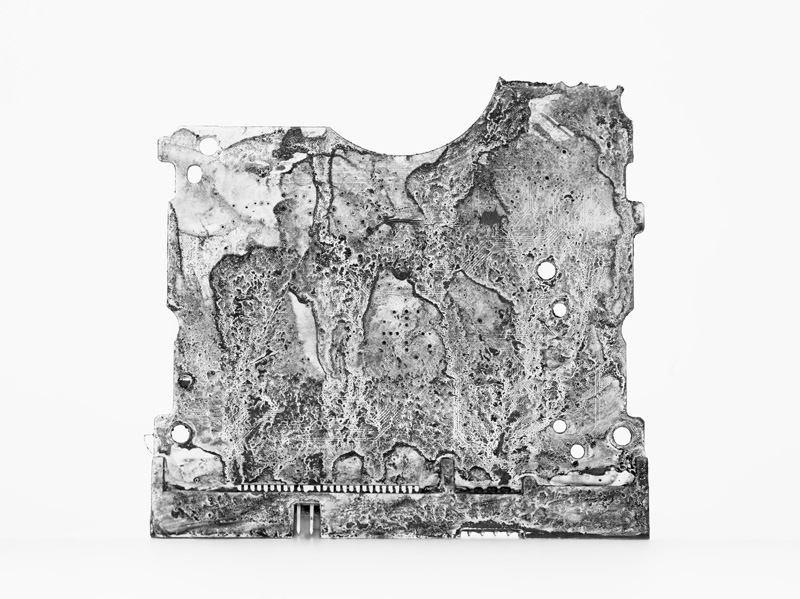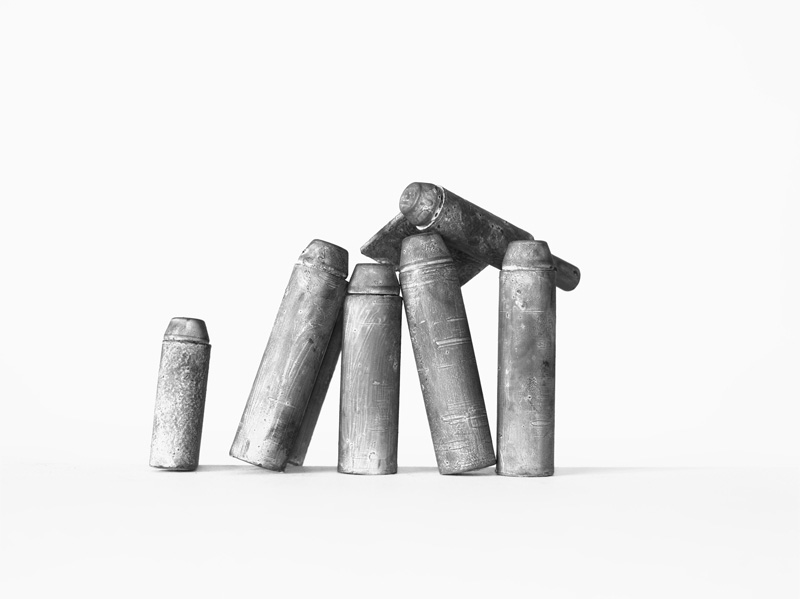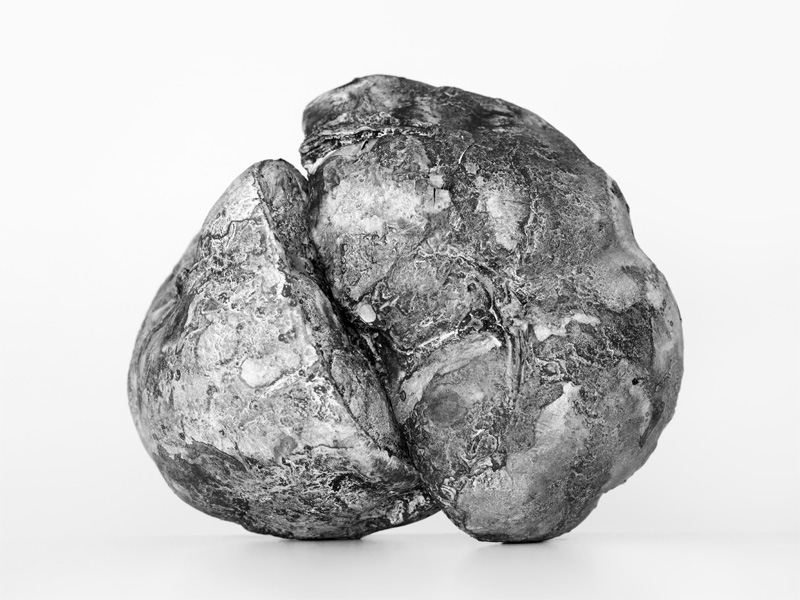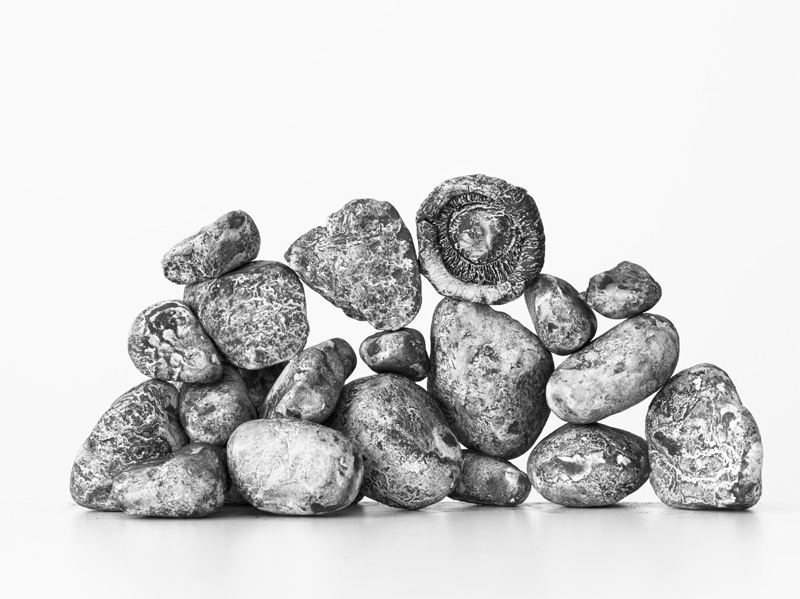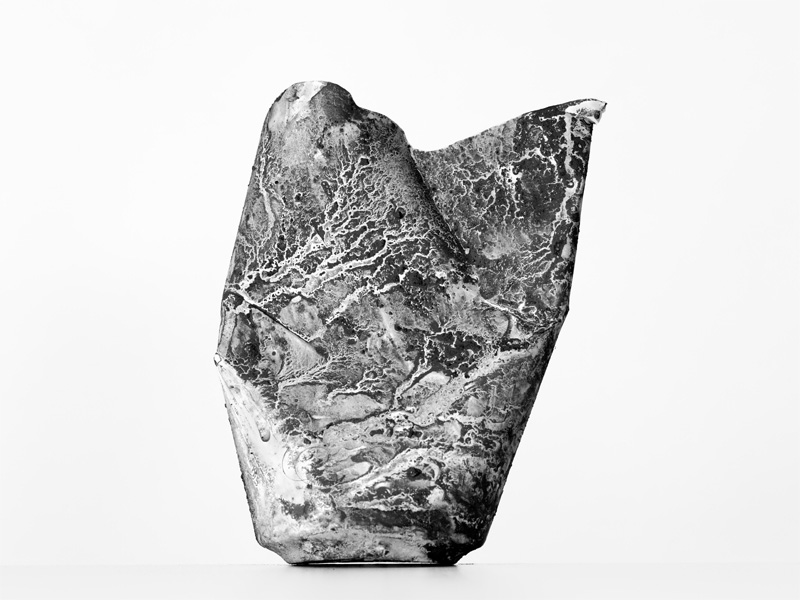The project started out as an odd imagination on afterlife. I imagine the world after death as a simple playground of wonders. In that world, everything is no longer an accustomed tool held in hand but is used in an unfamiliar way to induce a new kind of joy and cheer. Peculiar beings like tourists and drunks wander around this mysterious playground. Everything loses itself here.
제7회 KT&G 스코프(SKOPF, Sangsangmadang Korean Photographer's Fellowship)에서 올해의 최종작가로 선정된 권도연의 개인전 [고고학]이 KT&G 상상마당 갤러리에서 열린다. 작품들은 작가의 사후세계에 대한 사소한 상상으로부터 시작되었다. 권도연은 직접 삽으로 땅을 파 죽음을 맞이한 사물을 채취하여 이를 사진에 담았다. 이같은 과정을 통해 작가가 상상하는 사후세계에서 존재하는 사물들의 명랑하고 유쾌한 낯설음을 표현한다. 스코프의 심사위원인 이영준 기계비평가는 권도연의 작업에 대해 이를 시와 그림자극에 비유하며 “사진을 비워 낸 사진”이라 평했다. 전시에는 작가의 이전 작업인 ‘애송이의 여행’과 ‘개념어 사전’의 일부가 ‘고고학’시리즈와 함께 선보인다. 또한 12월에는 부산 고은사진미술관에서 스코프 올해의 작가인 김전기, 안종현과 함께하는 [사진미래색 2015]전이 예정돼있다.
Photography- A basket or a media?
To some people photography is a basket that can hold all things. The world is like an enormous marketplace, teeming with sorts of goods, technicolor and spectacles. It’s only natural for humans to stuff as much as possible when there is a large basket available. A person who has seen something precious tries to sweep in as many spectacles as possible to show them to the others. Then he or she claims oneself to be the witness to these spectacles. In English the word seer means a prophet. A seer doesn’t just see, but eyes the far that others cannot behold, and ahead of time too. Yet among those haste fully swept into the basket are what many have already seen as well as what no one has seen. Therefore the sweeper would discard what others have seen already and only leave behind the unseen. A sorting process of setting aside what ‘others probably have not seen’ is in effect here. As a result, the basket is transformed into a peculiar apparatus like telescope or microscope. The person who sees far and deep using such device is a true prophet, albeit that of science and not religion. He is a prophet who discovers the unknown star or microorganism, or a prophet who uncovers its new behavioral patterns. Can a photographer sweeping things into a basket be such a prophet? Sweep them in for now. After returning home, pick out those that others have not seen. Thus is produced an artwork. In the midst of commotion, something slips away. What did I see, what does it mean and what is hidden beneath? In what condition did I come to see that, how did it catch my eye, why did I think it was special? All questions fade away and only the spectacles remain. A normal basket would initiate an incredible self-removing function no matter how much a person has filled it. It’s not some extravagant magic but just one of the basket’s qualities. After all, a basket is there to be emptied. When going to a grocery store, one would only pick up a basket that is unfilled and not if there’s something in it. Therefore we must think about emptying it before filling it up. The basket of photography has a deformed habit of never fully emptying itself. Even at this moment people would take photographs until the memory cards in their camera become full and stock those photos in their computers and external hard drives until they are about to explode. Their smartphones too are packed with photos yet not many consider emptying them. The cameras and the computers are all equipped a delete button but it seems everyone is so scared of this function and can never empty the drives.Meanwhile photography is a media, an entity in the middle connecting one another. A basket and a media differ tremendously. Media, as its definition suggests only connects here to there in between. The words media, middle and median all have the same etymology. It means someone standing halfway trying to connect something. While a basket is an embodiment of possession and desire, media has nothing of such. Media is like the blue sky. Although there is seemingly nothing, look closely and you will see many things. You will see the eagle, the clouds, the daytime moon and even the galaxy afar. Media does not protrude in any way and become a pathway leading to many things. Media is only hollow. Media cannot be filled fundamentally. The bridge is left empty no matter how chaotic the city is, in order to get to the other side. Yet the greedy post modernistic men wish to take that media and turn it into a packed basket. Just as atom is consisted mostly of empty space save for the nucleus and electrons, the world full of media should be empty too. Yet this world again stuffs something into that hollow room.Originally media is a bridge linking the familiar world one stands in and the unfamiliar world over there. It’s a bridge of fear as crossing it meaning change of life and change of world. Therefore media should never be handled carelessly. Media is like a sharp knife or an axe; mishandle it and one can hurt oneself or take one to a strange, bizarre world. Yet in this age where every household raises a pet, even this fearsome media is tamed and turned into a feeble basket. Media is not the path to a new world but a pass or a key card to reconfirm the daily life tangled in media. Media is only a sealed road to media. Place things in a basket and buy them at a supermarket and the credit card company and the supermarket will use the big data to figure out what and when I have purchased. That is why every year in May strawberry prices fall and persimmons go on sale in October. Then I follow the cycle and fill my basket with the same items every year. Is not photography the same? Similar items always appear at similar times. We are being played by the basket’s cycle.
Photographers of this post modern age are obligated to redefine photography as media and not a basket. When everyone else is using the media as a basket and sweeping in this and that, a photographer must make media a tool of Zen. What does the constantly emptying photography signify? Isn’t poet a person who empties? Language of a poet contains nothing. ‘Keep to the right’ means only those walking on the right side will be accommodated. It does not matter whether others are faced with an accident. Instruction manual contains the product itself. It’s impossible to use the product without reading the manual. Unlike it, a poet’s language contains nothing. It means nothing can be accomplished by reading it. Poetry is a language that has emptied the language. Poem is like an empty frame. Looking at it makes one compulsive about filling it with something. It can be never understood that the empty frame itself is the story. Yet the poem remains as an empty frame until the end and make the emptiness its contents. Even with the slightest negligence others would soon fill it up. Accordingly the empty frame of poetry has a tendency of persistently and resolutely emptying itself. A high school literature teacher cannot bear that the poem is an empty frame.So he fills it up by explaining Silence of Love is about a lover or the motherland. Yet silence of love once gain empties itself as if in ridicule. Can photography be the same?
Doyeon Gwon’s photographs function in the same way as poetry. They are photographs that have emptied the photographs. There are no contents to contain. Well there are some but you can’t take them home, just as nobody takes home a basket from a supermarket. Gwon’s work offers objects, language and senses but only to empty them. Do not assume that the text appearing in Gwon’s photograph is language. Do not think objects shown in his image mean they are something. They are all emptied. If the goal of photography is to empty everything until the end, how is it any different from shadow boxing with fists thrown in the air or the empty handed golf swing practices of a middle aged man while he waits for the next train? What would happen if the photo is taken with an empty camera in order to empty the photograph? It is too easy. It only means to say what’s empty is empty. What is difficult, is to see the empty from the full and see the full from the empty. To take photographs with an empty camera is to suggest the structure of emptiness mono dimensionally which is equivalent to asking nothing. There cannot be an answer when there is no question. Doyeon Gwon questions after filling it up. Is it really not paper? Is it really garbage picked up from the abandoned piece of land? The answer is clear.It is not writing, paper or garbage. Photographs are shadows of objects from the current world that have leaped to the other world in conspiracy with the media.His photography is a shadow show. A shadow show is not an illusion. There is the movement of the shadows, there is the hidden force enabling the movement and there is the emotion within. What we see in the photo is movement of the photograph, hidden force enabling the movement and the emotion within. What would happen if something is added to it because it feels hollow? Will it be entertaining if the actual owners of the shadows are revealed just because the shadow show is not interesting enough? It won’t be because it means reversely transforming the media into the basket. It’s just like forcing a person taking a walk with empty hands to buy something and put purchased items into the basket. A shadow show has a perfectly empty structure. There is nothing to hold in the hand. It would have been rather interesting if photography resembled a shadow show. Yet it is more and more becoming a basket. Meanwhile Doyeon Gwon continues emptying the basket.
Man vs. basket. Whose victory is it?
Youngjun Lee • Machine Critic
To some people photography is a basket that can hold all things. The world is like an enormous marketplace, teeming with sorts of goods, technicolor and spectacles. It’s only natural for humans to stuff as much as possible when there is a large basket available. A person who has seen something precious tries to sweep in as many spectacles as possible to show them to the others. Then he or she claims oneself to be the witness to these spectacles. In English the word seer means a prophet. A seer doesn’t just see, but eyes the far that others cannot behold, and ahead of time too. Yet among those haste fully swept into the basket are what many have already seen as well as what no one has seen. Therefore the sweeper would discard what others have seen already and only leave behind the unseen. A sorting process of setting aside what ‘others probably have not seen’ is in effect here. As a result, the basket is transformed into a peculiar apparatus like telescope or microscope. The person who sees far and deep using such device is a true prophet, albeit that of science and not religion. He is a prophet who discovers the unknown star or microorganism, or a prophet who uncovers its new behavioral patterns. Can a photographer sweeping things into a basket be such a prophet? Sweep them in for now. After returning home, pick out those that others have not seen. Thus is produced an artwork. In the midst of commotion, something slips away. What did I see, what does it mean and what is hidden beneath? In what condition did I come to see that, how did it catch my eye, why did I think it was special? All questions fade away and only the spectacles remain. A normal basket would initiate an incredible self-removing function no matter how much a person has filled it. It’s not some extravagant magic but just one of the basket’s qualities. After all, a basket is there to be emptied. When going to a grocery store, one would only pick up a basket that is unfilled and not if there’s something in it. Therefore we must think about emptying it before filling it up. The basket of photography has a deformed habit of never fully emptying itself. Even at this moment people would take photographs until the memory cards in their camera become full and stock those photos in their computers and external hard drives until they are about to explode. Their smartphones too are packed with photos yet not many consider emptying them. The cameras and the computers are all equipped a delete button but it seems everyone is so scared of this function and can never empty the drives.Meanwhile photography is a media, an entity in the middle connecting one another. A basket and a media differ tremendously. Media, as its definition suggests only connects here to there in between. The words media, middle and median all have the same etymology. It means someone standing halfway trying to connect something. While a basket is an embodiment of possession and desire, media has nothing of such. Media is like the blue sky. Although there is seemingly nothing, look closely and you will see many things. You will see the eagle, the clouds, the daytime moon and even the galaxy afar. Media does not protrude in any way and become a pathway leading to many things. Media is only hollow. Media cannot be filled fundamentally. The bridge is left empty no matter how chaotic the city is, in order to get to the other side. Yet the greedy post modernistic men wish to take that media and turn it into a packed basket. Just as atom is consisted mostly of empty space save for the nucleus and electrons, the world full of media should be empty too. Yet this world again stuffs something into that hollow room.Originally media is a bridge linking the familiar world one stands in and the unfamiliar world over there. It’s a bridge of fear as crossing it meaning change of life and change of world. Therefore media should never be handled carelessly. Media is like a sharp knife or an axe; mishandle it and one can hurt oneself or take one to a strange, bizarre world. Yet in this age where every household raises a pet, even this fearsome media is tamed and turned into a feeble basket. Media is not the path to a new world but a pass or a key card to reconfirm the daily life tangled in media. Media is only a sealed road to media. Place things in a basket and buy them at a supermarket and the credit card company and the supermarket will use the big data to figure out what and when I have purchased. That is why every year in May strawberry prices fall and persimmons go on sale in October. Then I follow the cycle and fill my basket with the same items every year. Is not photography the same? Similar items always appear at similar times. We are being played by the basket’s cycle.
Photographers of this post modern age are obligated to redefine photography as media and not a basket. When everyone else is using the media as a basket and sweeping in this and that, a photographer must make media a tool of Zen. What does the constantly emptying photography signify? Isn’t poet a person who empties? Language of a poet contains nothing. ‘Keep to the right’ means only those walking on the right side will be accommodated. It does not matter whether others are faced with an accident. Instruction manual contains the product itself. It’s impossible to use the product without reading the manual. Unlike it, a poet’s language contains nothing. It means nothing can be accomplished by reading it. Poetry is a language that has emptied the language. Poem is like an empty frame. Looking at it makes one compulsive about filling it with something. It can be never understood that the empty frame itself is the story. Yet the poem remains as an empty frame until the end and make the emptiness its contents. Even with the slightest negligence others would soon fill it up. Accordingly the empty frame of poetry has a tendency of persistently and resolutely emptying itself. A high school literature teacher cannot bear that the poem is an empty frame.So he fills it up by explaining Silence of Love is about a lover or the motherland. Yet silence of love once gain empties itself as if in ridicule. Can photography be the same?
Doyeon Gwon’s photographs function in the same way as poetry. They are photographs that have emptied the photographs. There are no contents to contain. Well there are some but you can’t take them home, just as nobody takes home a basket from a supermarket. Gwon’s work offers objects, language and senses but only to empty them. Do not assume that the text appearing in Gwon’s photograph is language. Do not think objects shown in his image mean they are something. They are all emptied. If the goal of photography is to empty everything until the end, how is it any different from shadow boxing with fists thrown in the air or the empty handed golf swing practices of a middle aged man while he waits for the next train? What would happen if the photo is taken with an empty camera in order to empty the photograph? It is too easy. It only means to say what’s empty is empty. What is difficult, is to see the empty from the full and see the full from the empty. To take photographs with an empty camera is to suggest the structure of emptiness mono dimensionally which is equivalent to asking nothing. There cannot be an answer when there is no question. Doyeon Gwon questions after filling it up. Is it really not paper? Is it really garbage picked up from the abandoned piece of land? The answer is clear.It is not writing, paper or garbage. Photographs are shadows of objects from the current world that have leaped to the other world in conspiracy with the media.His photography is a shadow show. A shadow show is not an illusion. There is the movement of the shadows, there is the hidden force enabling the movement and there is the emotion within. What we see in the photo is movement of the photograph, hidden force enabling the movement and the emotion within. What would happen if something is added to it because it feels hollow? Will it be entertaining if the actual owners of the shadows are revealed just because the shadow show is not interesting enough? It won’t be because it means reversely transforming the media into the basket. It’s just like forcing a person taking a walk with empty hands to buy something and put purchased items into the basket. A shadow show has a perfectly empty structure. There is nothing to hold in the hand. It would have been rather interesting if photography resembled a shadow show. Yet it is more and more becoming a basket. Meanwhile Doyeon Gwon continues emptying the basket.
Man vs. basket. Whose victory is it?
Youngjun Lee • Machine Critic
사진,바구니가될것인가, 미디어가될것인가?
어떤 이들에게 사진은 바구니다. 이것저것 쓸어 담을 수 있는 바구니. 이 세상은 넓은 시장 같아서 온갖 물건과 색깔과 스펙터클로 넘쳐난다. 큰 바구니만 있다면 최대한 많이 담고 싶은 것이 사람의 욕심이다. 진기한 것을 보면 스펙터클을 최대한 많이 쓸어 담아서 다른 사람들에게 보여 주고 싶어 한다. 그리고 스펙터클을 본 사람으로 자신을 내세운다. 영어에서 보는 사람, 즉 seer는 선지자를 의미한다. 그냥 보는 게 아니라 남들이 못 보는 걸 멀리, 미리 보는 사람이다. 그런데 바구니에 정신없이 쓸어 담은 것 중에는 이미 많은 사람이 본 것도 있고 못 본 것도 있다. 그래서 남들이 이미 본 것은 버리고 못 본 것만 남겨 둔다.‘남들이 못 봤을 것’이라고 생각되는 것만 남겨 두고 나머지는 버리는 선별 가공 과정을 거치는 것이다. 그렇게 하여 바구니는 망원경이나 현미경 같은 희한한 장치로 탈바꿈한다. 그런 장치로 멀리, 깊이 보는 사람은 정말로 선지자다. 다만 종교의 선지자가 아니라 과학의 선지자일 뿐이다. 이제껏 발견되지 않은 별이나 미생물을 발견하는 선지자다. 혹은 그런 것들의 새로운 행동 패턴을 발견해 내는 선지자이기도 하다. 바구니에 쓸어 담는 사진가가 그런 선지자일 수 있을까? 일단 마구 쓸어 담는다. 나중에 집에 와서 남들이 못 본 것만 선별 가공해 낸다. 그 결과 작품이 생겨난다. 그 바쁜 와중에서 뭔가가 빠져나간다. 내가 뭘 봤더라, 그 의미는 뭐고 숨은 뜻은 뭐더라, 저게 보이게 된 맥락은 뭐더라, 왜 내 눈에 띄었더라, 왜 나는 그것을 특별하게 봤더라 등의 질문은 스르르 빠져나가고 스펙터클만 남는다. 온전한 바구니라면 아무리 많은 것을 쓸어 담아도 스스로를 비워 내는 놀라운 작용을 한다. 무슨 대단한 마술이 아니라 바구니의 속성일 뿐이다. 바구니는 비우라고 있는 것이니 말이다. 마트에 갔을 때 빈 바구니를 집어 들지 뭔가 들어 있는 바구니를 집어 드는 사람은 없지 않은가. 그러니 쓸어 담기 전에 비울 생각부터 해야 한다. 사진이라는 바구니는 절대 비워지지 않는 기형의 버릇을 가지고 있다. 오늘도 사람들은 카메라의 메모리가 다 찰 때까지 사진을 찍고 그 사진들을 컴퓨터 하드와 외장 하드가 꽉 차도록 쟁여 놓는다. 스마트폰도 마찬가지다. 이제껏 찍은 사진으로 메모리가 다 찼는데 좀처럼 비울 생각을 못 한다. 카메라도 컴퓨터도 분명히 딜리트 기능이 있건만 사람들은 그 기능이 가장 무서운지 절대로 비워 내지 못한다.그런데 사진은 미디어이기도 하다. 중간에 서서 연결해 주는 자다. 바구니와 미디어는 많이 다르다. 미디어는 쓸어 담지 않는다. 미디어는 중간이라는 말뜻이 시사하듯이 이것과 저것 중간에서 이어 줄 뿐이다. media와 middle, median 은 어원이 같다. 중간에 서서 뭔가를 연결해 주는 자라는 뜻이다. 바구니가 소유하려는 욕심의 화신이라면 미디어는 아무 욕심이 없다. 미디어는 푸른 하늘 같은 것이다. 하늘에 아무것도 없지만 잘 들여다보면 많은 것이 보인다. 독수리도 보이고 구름도 보이고 낮달도 보이고 저 멀리 은하계도 보인다. 미디어는 스스로 아무것도 내세우지 않으면서 많은 것으로 가는 통로가 돼 준다. 미디어는 허허롭기만 할 뿐이다. 미디어는 근본적으로 채울 수 없는 것이다. 아무리 복잡한 도시에서도 다리를 비워 두는 이유는 저쪽으로 건너가야 하기 때문이다. 그런데 그 미디어마저 가득 찬 바구니로 만들고자 하는 것이 포스트모던 인간의 욕심이다. 원자의 대부분이 원자핵과 전자만 빼면 빈 공간이듯이 미디어로 가득 찬 세계도 텅 비어야 하는데 그 빈 공간에 또 뭔가를 가득 채워 넣는다. 원래 미디어란 지금 내가 서 있는 익숙한 세계와 저쪽에 있는 낯선 세계를 연결해 주는 다리다. 그 다리를 건너면 인생이 바뀌고 세계가 바뀌는 두려운 다리다. 그래서 미디어는 함부로 다루면 안 되는 것이다. 미디어란 회칼이나 도끼 같아서 잘못 다루면 내가 상처 입을 수도 있고 나를 이상한 세계에 데려다 놓을 수도 있다. 그런데 집집마다 반려동물을 기르는 요즘은 그런 무서운 미디어도 길들여서 만만한 바구니로 만들어 버렸다. 미디어는 낯 선 세계로 가는 통로가 아니라 미디어로 얽힌 일상 세계를 재확인하는 출입증이나 보안 카드일 뿐이다. 미디어는 미디어로 가는 폐쇄적 통로일 뿐이다. 마트에서 바구니에 물건을 담고 계산하면 마트와 신용 카드 회사는 빅 데이터를 활용하여 내가 언제 무슨 물건을 사는지 다 안다. 그래서 해마다 5월이 되면 딸기를 싼 값에 내놓고 10월에는 청도 곶감을 세일한다. 나는 그 사이클에 따라 해마다 같은 품목을 바구니에 담는다. 사진도 이 꼴이 아닌가? 항상 비슷한 소재가 비슷한 시기에 등장한다. 바구니의 사이클에 놀아난 꼴이다.
포스트모던 시대의 사진가는 사진을 바구니가 아니라 미디어로 재정의해야 하는 의무를 지고 있다. 모든 사람이 미디어를 바구니로 활용하여 이것저것 쓸어 담을 때 미디어를 강태공의 빈 낚싯바늘로 만드는 것이다. 항상 비워 내는 사진이란 무엇일까? 시인이야말로 비워 내는 사람 아닐까? 시인의 언어는 어떤 것도 담지 않는다.‘우측 통행’은 오른쪽으로 가는 사람만 담겠다는 말이다. 나머지는 사고가 나든지 말든지다. 제품 사용 설명서는 제품 자체를 담고 있다. 그걸 읽지 않으면 제품을 쓸 수 없으니 말이다.반면 시인의 언어는 어떤 것도 담지 않는다. 그걸 읽어서 이룰 수 있는 것이 아무것도 없다는 말이다. 시는 언어를 비워 낸 언어다. 시는 빈 액자와 같다. 그걸 보는 사람은 뭔가를 채워 넣어야 할 것 같은 강박 관념을 느낀다. 빈 액자 자체가 내용이라는 사실을 결코 이해할 수 없다. 그러나 시는 끝까지빈 액자로 남아서 빔 자체를 콘텐츠로 삼는다. 섣불리 놔 뒀다가는 곧 다른 사람들이 그것을 채워 버리기 때문에 시라는 빈 액자는 끈질기고도 강력하게 스스로를 비워 내는 관성을 갖는다. 고등학교 국어 선생님은 시가 빈액자인 것을 참을 수 없다.‘님의 침묵’의 님은 사랑하는 사람이기도 하고 조국이기도 하다고 그럴싸하게 설명하여 액자를 채워 버린다. 그러나 님의 침묵은 비웃기라도 하듯 또 스스로를 비워 내 버린다. 사진도 그럴 수 있을까?
권도연의 사진은 시처럼 기능한다. 사진을 비워 낸 사진이다. 거기에는 담아낼 콘텐츠가 없다. 있기는 한데 집으로 가져갈 수 없다. 마트의 바구니를 집에 가져가는 사람은 없듯이 말이다. 권도연의 사진은 사물과 언어와 감각을 다루지만 비우기 위해 다룬다. 권도연의 사진에 글씨가 나온다고 해서 그게 말이라고 생각하면 안 된다. 그의 사진에 사물이 나온다고 어떤 물건이라고 생각하면 안 된다. 다 비웠기 때문이다. 끝까지 모든 것을 비워 내는 것이 사진의 목적이라면 허공에 대고 주먹을 휘두르는 섀도 복싱이나, 중년 아저씨가 지하철 기다리면서 빈 손으로 골프 스윙을 연습하는 것과 뭐가 다를까. 사진을 비워 낸답시고 빈 카메라로 찍으면 어떻게 될까? 그건 너무 쉽다. 빈 것을 비었다고 얘기하는 꼴이기 때문이다. 꽉 찬 데서 빈 것을 보고, 빈 데에서 찬 것을 보는 일이 어렵다. 빈 카메라로 찍는 것은 비워 냄의 구조를 1차원으로만 제시하기 때문에 아무런 질문도 하지 않는 꼴이 된다. 질문이 없는데 답이 있을 리 없다. 권도연은 채워 넣고 질문한다. 이게 정말로 글씨란 말인가? 이게 정말로 종이란 말인가? 이게 정말로 쓰레기장에서 주워 온 폐품이란 말인가? 대답이 분명하다. 글씨도 아니고 종이도 아니고 폐품도 아니다. 사진이란 미디어와 협잡하여 다른 세계로 넘어가 버린 현 세계 사물들의 그림자일 뿐이다.그의 사진은 그림자극이다. 그림자극은 허깨비가 아니다. 그림자의 동작이 있고 동작을 가능케 하는 배후의 힘이 있고 거기 실린 감정이 있다. 우리가 사진에서 보는 것도 사진의 동작이고 그것을 가능케 하는 배후의 힘이고 거기 실린 감정이다. 그것들이 공허하다고 뭘 실으면 어떻게 될까? 그림자 연극이 재미없다고 그림자의 실물을 무대 위에 보여 준다면 재미있을까? 미디어를 거꾸로 바구니로 만드는 것이기 때문에 재미없을 것이다. 빈손으로 산책하는 사람에게 자꾸 물건을 사서 바구니에 담으라고 하는 꼴이니 말이다. 그림자극은 완벽하게 빈 구조다. 아무것도 손에 잡을 것이 없으니 말이다. 사진이 차라리 그림자 연극을 닮았다면 재미있었을 것이다. 그런데 사진이 자꾸 바구니가 되어 간다. 반면 권도연은 바구니를 자꾸 비워 낸다.
인간 대 바구니, 누가 이길 것인가.
이영준 • 기계비평가
어떤 이들에게 사진은 바구니다. 이것저것 쓸어 담을 수 있는 바구니. 이 세상은 넓은 시장 같아서 온갖 물건과 색깔과 스펙터클로 넘쳐난다. 큰 바구니만 있다면 최대한 많이 담고 싶은 것이 사람의 욕심이다. 진기한 것을 보면 스펙터클을 최대한 많이 쓸어 담아서 다른 사람들에게 보여 주고 싶어 한다. 그리고 스펙터클을 본 사람으로 자신을 내세운다. 영어에서 보는 사람, 즉 seer는 선지자를 의미한다. 그냥 보는 게 아니라 남들이 못 보는 걸 멀리, 미리 보는 사람이다. 그런데 바구니에 정신없이 쓸어 담은 것 중에는 이미 많은 사람이 본 것도 있고 못 본 것도 있다. 그래서 남들이 이미 본 것은 버리고 못 본 것만 남겨 둔다.‘남들이 못 봤을 것’이라고 생각되는 것만 남겨 두고 나머지는 버리는 선별 가공 과정을 거치는 것이다. 그렇게 하여 바구니는 망원경이나 현미경 같은 희한한 장치로 탈바꿈한다. 그런 장치로 멀리, 깊이 보는 사람은 정말로 선지자다. 다만 종교의 선지자가 아니라 과학의 선지자일 뿐이다. 이제껏 발견되지 않은 별이나 미생물을 발견하는 선지자다. 혹은 그런 것들의 새로운 행동 패턴을 발견해 내는 선지자이기도 하다. 바구니에 쓸어 담는 사진가가 그런 선지자일 수 있을까? 일단 마구 쓸어 담는다. 나중에 집에 와서 남들이 못 본 것만 선별 가공해 낸다. 그 결과 작품이 생겨난다. 그 바쁜 와중에서 뭔가가 빠져나간다. 내가 뭘 봤더라, 그 의미는 뭐고 숨은 뜻은 뭐더라, 저게 보이게 된 맥락은 뭐더라, 왜 내 눈에 띄었더라, 왜 나는 그것을 특별하게 봤더라 등의 질문은 스르르 빠져나가고 스펙터클만 남는다. 온전한 바구니라면 아무리 많은 것을 쓸어 담아도 스스로를 비워 내는 놀라운 작용을 한다. 무슨 대단한 마술이 아니라 바구니의 속성일 뿐이다. 바구니는 비우라고 있는 것이니 말이다. 마트에 갔을 때 빈 바구니를 집어 들지 뭔가 들어 있는 바구니를 집어 드는 사람은 없지 않은가. 그러니 쓸어 담기 전에 비울 생각부터 해야 한다. 사진이라는 바구니는 절대 비워지지 않는 기형의 버릇을 가지고 있다. 오늘도 사람들은 카메라의 메모리가 다 찰 때까지 사진을 찍고 그 사진들을 컴퓨터 하드와 외장 하드가 꽉 차도록 쟁여 놓는다. 스마트폰도 마찬가지다. 이제껏 찍은 사진으로 메모리가 다 찼는데 좀처럼 비울 생각을 못 한다. 카메라도 컴퓨터도 분명히 딜리트 기능이 있건만 사람들은 그 기능이 가장 무서운지 절대로 비워 내지 못한다.그런데 사진은 미디어이기도 하다. 중간에 서서 연결해 주는 자다. 바구니와 미디어는 많이 다르다. 미디어는 쓸어 담지 않는다. 미디어는 중간이라는 말뜻이 시사하듯이 이것과 저것 중간에서 이어 줄 뿐이다. media와 middle, median 은 어원이 같다. 중간에 서서 뭔가를 연결해 주는 자라는 뜻이다. 바구니가 소유하려는 욕심의 화신이라면 미디어는 아무 욕심이 없다. 미디어는 푸른 하늘 같은 것이다. 하늘에 아무것도 없지만 잘 들여다보면 많은 것이 보인다. 독수리도 보이고 구름도 보이고 낮달도 보이고 저 멀리 은하계도 보인다. 미디어는 스스로 아무것도 내세우지 않으면서 많은 것으로 가는 통로가 돼 준다. 미디어는 허허롭기만 할 뿐이다. 미디어는 근본적으로 채울 수 없는 것이다. 아무리 복잡한 도시에서도 다리를 비워 두는 이유는 저쪽으로 건너가야 하기 때문이다. 그런데 그 미디어마저 가득 찬 바구니로 만들고자 하는 것이 포스트모던 인간의 욕심이다. 원자의 대부분이 원자핵과 전자만 빼면 빈 공간이듯이 미디어로 가득 찬 세계도 텅 비어야 하는데 그 빈 공간에 또 뭔가를 가득 채워 넣는다. 원래 미디어란 지금 내가 서 있는 익숙한 세계와 저쪽에 있는 낯선 세계를 연결해 주는 다리다. 그 다리를 건너면 인생이 바뀌고 세계가 바뀌는 두려운 다리다. 그래서 미디어는 함부로 다루면 안 되는 것이다. 미디어란 회칼이나 도끼 같아서 잘못 다루면 내가 상처 입을 수도 있고 나를 이상한 세계에 데려다 놓을 수도 있다. 그런데 집집마다 반려동물을 기르는 요즘은 그런 무서운 미디어도 길들여서 만만한 바구니로 만들어 버렸다. 미디어는 낯 선 세계로 가는 통로가 아니라 미디어로 얽힌 일상 세계를 재확인하는 출입증이나 보안 카드일 뿐이다. 미디어는 미디어로 가는 폐쇄적 통로일 뿐이다. 마트에서 바구니에 물건을 담고 계산하면 마트와 신용 카드 회사는 빅 데이터를 활용하여 내가 언제 무슨 물건을 사는지 다 안다. 그래서 해마다 5월이 되면 딸기를 싼 값에 내놓고 10월에는 청도 곶감을 세일한다. 나는 그 사이클에 따라 해마다 같은 품목을 바구니에 담는다. 사진도 이 꼴이 아닌가? 항상 비슷한 소재가 비슷한 시기에 등장한다. 바구니의 사이클에 놀아난 꼴이다.
포스트모던 시대의 사진가는 사진을 바구니가 아니라 미디어로 재정의해야 하는 의무를 지고 있다. 모든 사람이 미디어를 바구니로 활용하여 이것저것 쓸어 담을 때 미디어를 강태공의 빈 낚싯바늘로 만드는 것이다. 항상 비워 내는 사진이란 무엇일까? 시인이야말로 비워 내는 사람 아닐까? 시인의 언어는 어떤 것도 담지 않는다.‘우측 통행’은 오른쪽으로 가는 사람만 담겠다는 말이다. 나머지는 사고가 나든지 말든지다. 제품 사용 설명서는 제품 자체를 담고 있다. 그걸 읽지 않으면 제품을 쓸 수 없으니 말이다.반면 시인의 언어는 어떤 것도 담지 않는다. 그걸 읽어서 이룰 수 있는 것이 아무것도 없다는 말이다. 시는 언어를 비워 낸 언어다. 시는 빈 액자와 같다. 그걸 보는 사람은 뭔가를 채워 넣어야 할 것 같은 강박 관념을 느낀다. 빈 액자 자체가 내용이라는 사실을 결코 이해할 수 없다. 그러나 시는 끝까지빈 액자로 남아서 빔 자체를 콘텐츠로 삼는다. 섣불리 놔 뒀다가는 곧 다른 사람들이 그것을 채워 버리기 때문에 시라는 빈 액자는 끈질기고도 강력하게 스스로를 비워 내는 관성을 갖는다. 고등학교 국어 선생님은 시가 빈액자인 것을 참을 수 없다.‘님의 침묵’의 님은 사랑하는 사람이기도 하고 조국이기도 하다고 그럴싸하게 설명하여 액자를 채워 버린다. 그러나 님의 침묵은 비웃기라도 하듯 또 스스로를 비워 내 버린다. 사진도 그럴 수 있을까?
권도연의 사진은 시처럼 기능한다. 사진을 비워 낸 사진이다. 거기에는 담아낼 콘텐츠가 없다. 있기는 한데 집으로 가져갈 수 없다. 마트의 바구니를 집에 가져가는 사람은 없듯이 말이다. 권도연의 사진은 사물과 언어와 감각을 다루지만 비우기 위해 다룬다. 권도연의 사진에 글씨가 나온다고 해서 그게 말이라고 생각하면 안 된다. 그의 사진에 사물이 나온다고 어떤 물건이라고 생각하면 안 된다. 다 비웠기 때문이다. 끝까지 모든 것을 비워 내는 것이 사진의 목적이라면 허공에 대고 주먹을 휘두르는 섀도 복싱이나, 중년 아저씨가 지하철 기다리면서 빈 손으로 골프 스윙을 연습하는 것과 뭐가 다를까. 사진을 비워 낸답시고 빈 카메라로 찍으면 어떻게 될까? 그건 너무 쉽다. 빈 것을 비었다고 얘기하는 꼴이기 때문이다. 꽉 찬 데서 빈 것을 보고, 빈 데에서 찬 것을 보는 일이 어렵다. 빈 카메라로 찍는 것은 비워 냄의 구조를 1차원으로만 제시하기 때문에 아무런 질문도 하지 않는 꼴이 된다. 질문이 없는데 답이 있을 리 없다. 권도연은 채워 넣고 질문한다. 이게 정말로 글씨란 말인가? 이게 정말로 종이란 말인가? 이게 정말로 쓰레기장에서 주워 온 폐품이란 말인가? 대답이 분명하다. 글씨도 아니고 종이도 아니고 폐품도 아니다. 사진이란 미디어와 협잡하여 다른 세계로 넘어가 버린 현 세계 사물들의 그림자일 뿐이다.그의 사진은 그림자극이다. 그림자극은 허깨비가 아니다. 그림자의 동작이 있고 동작을 가능케 하는 배후의 힘이 있고 거기 실린 감정이 있다. 우리가 사진에서 보는 것도 사진의 동작이고 그것을 가능케 하는 배후의 힘이고 거기 실린 감정이다. 그것들이 공허하다고 뭘 실으면 어떻게 될까? 그림자 연극이 재미없다고 그림자의 실물을 무대 위에 보여 준다면 재미있을까? 미디어를 거꾸로 바구니로 만드는 것이기 때문에 재미없을 것이다. 빈손으로 산책하는 사람에게 자꾸 물건을 사서 바구니에 담으라고 하는 꼴이니 말이다. 그림자극은 완벽하게 빈 구조다. 아무것도 손에 잡을 것이 없으니 말이다. 사진이 차라리 그림자 연극을 닮았다면 재미있었을 것이다. 그런데 사진이 자꾸 바구니가 되어 간다. 반면 권도연은 바구니를 자꾸 비워 낸다.
인간 대 바구니, 누가 이길 것인가.
이영준 • 기계비평가
The art of shovel (2015)
The project started out as an odd imagination on afterlife. I imagine the world after death as a simple playground of wonders. In that world, everything is no longer an accustomed tool held in hand but is used in an unfamiliar way to induce a new kind of joy and cheer. Peculiar beings like tourists and drunks wander around this mysterious playground. Everything loses itself here.
The first step was purchasing a small shovel. After work I would return to my studio and roam around the place with my dog, the shovel in my hand. Then as if I am a serious archeologist, I would dig up the ground and lay out what I’ve found on the table to observe. Ignoring the functionality of the objects, I focused on seeking possibilities other than those functionalities. In this way, I had wished to hold onto the functionally degraded objects and discover something from them. As the project proceeded, such act seemed to be an intense temptation and danger. Shoveling is an act of opening up the image and at the same time an act of filling it up. Now as the image is no longer functionally instrumental and faced squarely, it is exposed to the temptation and insecurity even more directly.
Shovel versus human. Which will be buried?
Dictionary of Notion (2014)
Prior to this work, I took pictures of moments when an existence of something appeared on a piece of paper. It was a joyful experience where reasoning on a limited object was expanded. And I wanted to put it in an ideational setting called ‘notion’ to reconfigure it on a broad scope. At first, I wrote down over 300 words to describe one’s mind and heart in a note-book. It was well over one notebook as I wrote down even the words with subtle differences in nuances. Then, I collected words that were thrown in a waste paper treatment facility.
I could feel a sense of freedom among the dictionaries with worn-out utility, which was detached from the inherent functional and directional roles I came to think that as long as an object is identified within the instrumental usage, the object becomes invisible. It is when an instrument is broken that you get to sense the existence of the instrument. Comfortable shoes are felt as if they are not worn, and an obedient lover is not felt like a different being from his or her lover. What surrounds us can become ‘preciously invisible’ only by fulfilling its usage and maximizing the reliability.
However, for me, showing the hidden existence in an instrumental manner has become important, because photography is ‘the proof of existence’ of the invisible. I make the dictionary of notion by compiling my notions. These words might not be likely to be the fragments of your lost impressions, but I pin myself on the likelihood, and also on the unlikelihood.
Traveller Novice (2011)
Before I began to understand the world through books, there was a time when I learned about it through folding pieces of paper. That I could make several shapes appear from a single sheet was a mystery. Eventually my mind reconciled with the fact that a new object could appear after the dexterous movements of hands against the soft material of paper. Books later showed me the secret that myriad worlds are born from only one. Reading a book, which leaves deep impressions, is to infinitely produce many folds. When we read, we share words and thoughts and connect them simultaneously. We continue to do this in the mist of an image that appears around the point of contact between paper and ink, object and thought.
Books can easily be distinguished as either “read” or “not read.” Only a thorough reading can create that unique fluffing of pages. My photographic works express the fact that paper and books, icons of knowledge, are merely physical entities. However, we recognize the presence of another dimension as soon as we enter their realm.
Doyeon Gwon
The project started out as an odd imagination on afterlife. I imagine the world after death as a simple playground of wonders. In that world, everything is no longer an accustomed tool held in hand but is used in an unfamiliar way to induce a new kind of joy and cheer. Peculiar beings like tourists and drunks wander around this mysterious playground. Everything loses itself here.
The first step was purchasing a small shovel. After work I would return to my studio and roam around the place with my dog, the shovel in my hand. Then as if I am a serious archeologist, I would dig up the ground and lay out what I’ve found on the table to observe. Ignoring the functionality of the objects, I focused on seeking possibilities other than those functionalities. In this way, I had wished to hold onto the functionally degraded objects and discover something from them. As the project proceeded, such act seemed to be an intense temptation and danger. Shoveling is an act of opening up the image and at the same time an act of filling it up. Now as the image is no longer functionally instrumental and faced squarely, it is exposed to the temptation and insecurity even more directly.
Shovel versus human. Which will be buried?
Dictionary of Notion (2014)
Prior to this work, I took pictures of moments when an existence of something appeared on a piece of paper. It was a joyful experience where reasoning on a limited object was expanded. And I wanted to put it in an ideational setting called ‘notion’ to reconfigure it on a broad scope. At first, I wrote down over 300 words to describe one’s mind and heart in a note-book. It was well over one notebook as I wrote down even the words with subtle differences in nuances. Then, I collected words that were thrown in a waste paper treatment facility.
I could feel a sense of freedom among the dictionaries with worn-out utility, which was detached from the inherent functional and directional roles I came to think that as long as an object is identified within the instrumental usage, the object becomes invisible. It is when an instrument is broken that you get to sense the existence of the instrument. Comfortable shoes are felt as if they are not worn, and an obedient lover is not felt like a different being from his or her lover. What surrounds us can become ‘preciously invisible’ only by fulfilling its usage and maximizing the reliability.
However, for me, showing the hidden existence in an instrumental manner has become important, because photography is ‘the proof of existence’ of the invisible. I make the dictionary of notion by compiling my notions. These words might not be likely to be the fragments of your lost impressions, but I pin myself on the likelihood, and also on the unlikelihood.
Traveller Novice (2011)
Before I began to understand the world through books, there was a time when I learned about it through folding pieces of paper. That I could make several shapes appear from a single sheet was a mystery. Eventually my mind reconciled with the fact that a new object could appear after the dexterous movements of hands against the soft material of paper. Books later showed me the secret that myriad worlds are born from only one. Reading a book, which leaves deep impressions, is to infinitely produce many folds. When we read, we share words and thoughts and connect them simultaneously. We continue to do this in the mist of an image that appears around the point of contact between paper and ink, object and thought.
Books can easily be distinguished as either “read” or “not read.” Only a thorough reading can create that unique fluffing of pages. My photographic works express the fact that paper and books, icons of knowledge, are merely physical entities. However, we recognize the presence of another dimension as soon as we enter their realm.
Doyeon Gwon
고고학
이 작업은 사후 세계에 대한 엉뚱한 상상에서 비롯됐다. 내가 상상하는 사후 세계는 가벼운 신비의 놀이터다. 그곳에서는 모든 사물이 손 안의 친근한 도구가 아니라 새로운 유쾌함과 명랑함을 유발하는 낯선 쓰임을 가지고 등장한다. 이 신비한 놀이터에는 관광객이나 술주정뱅이 같은 엉뚱한 존재들이 어슬렁거린다. 이곳에서는 모든 것이 자기 자신을 잃는다.
작업은 작은 삽을 구입하는 것으로 시작했다. 일을 마친 후 작업실로 돌아와 삽을 들고 개와 함께 작업실 주변을 어슬렁거렸다. 그리고 고고학자가 된 것처럼 진지하게 땅을 파고, 발견한 사물들을 테이블에 놓고 관찰했다. 사물의 효용성에 무심한 채 그 효용성을 제외한 다른 가능성을 탐색하는 데 집중했다. 나는 기능이 퇴화한 사물을 붙잡고 거기에서 무언가를 발견하고 싶었다. 작업을 진행하며 이러한 행위들은 나에게 커다란 유혹이자 동시에 위험이라고 생각했다. 삽질을 한다는 것은 이미지를 열어젖히는 행위인 동시에 메우는 행위다. 이제는 이미지를 기능으로 수단화하지 않고 정면으로 마주하려는 점에서 저 유혹과 불안에 더 직접적으로 노출되었다.
개념어 사전
이번 작업을 시작하기 전, 한 줌의 종이에서 존재가 드러날 때의 순간들을 사진으로 담아 왔다. 이를 통해 한정된 대상에 대해 사유가 확장되는 즐거운 경험을 했다. 그리고 이를 개념어라는 관념적 설정에 담아 좀 더 넓은 의미의 토대에서 재구성하고 싶었다. 처음에는 삼백 가지가 넘는 마음의 낱말을 모아서 수첩에 적었다. 미세한 차이를 지닌 낱말까지 적어 두자니 노트 한 권을 훌쩍 넘는 듯했다. 그러고 나서 폐지 처리장에 버려진 사전들을 수집했다. 유용성이 소진되어 폐지로 버려진 사전을 보며 기능적이고 지시적인 본래 역할에서 벗어난 자유로움을 느낄 수 있었다.
사물이 도구의 용도로 파악되는 한 그 사물은 눈앞에 드러나지 않는 법이다. 도구의 존재감을 눈앞에서 강렬하게 느끼는 것은 그 도구가 망가졌을 때뿐이다. 편안한 신발은 신지 않은 것처럼 여겨지고, 고분고분한 연인은 나와 다른 존재로 느껴지지 않는다. 우리를 둘러싼 것들은 그 쓰임을 충실히 이행하고 신뢰도를 최대화해야만 ‘사랑스럽게 눈앞에 없는’것이 될 수 있다. 하지만 나는 도구의 방식으로 눈앞에서 사라진 존재를 드러내는 것이 중요해 보였다. 나에게 사진은 눈앞에 없는 것들의‘존재의 증명’이기 때문이다.
이런 개념을 정리하며‘개념어 사전’을 만들어 본다. 이 단어들이 타인이 잃어버린 인상의 조각일 확률은 극히 작지만 그 확률에 자신을 걸고 불가능성에 자신을 건다.
권도연
이 작업은 사후 세계에 대한 엉뚱한 상상에서 비롯됐다. 내가 상상하는 사후 세계는 가벼운 신비의 놀이터다. 그곳에서는 모든 사물이 손 안의 친근한 도구가 아니라 새로운 유쾌함과 명랑함을 유발하는 낯선 쓰임을 가지고 등장한다. 이 신비한 놀이터에는 관광객이나 술주정뱅이 같은 엉뚱한 존재들이 어슬렁거린다. 이곳에서는 모든 것이 자기 자신을 잃는다.
작업은 작은 삽을 구입하는 것으로 시작했다. 일을 마친 후 작업실로 돌아와 삽을 들고 개와 함께 작업실 주변을 어슬렁거렸다. 그리고 고고학자가 된 것처럼 진지하게 땅을 파고, 발견한 사물들을 테이블에 놓고 관찰했다. 사물의 효용성에 무심한 채 그 효용성을 제외한 다른 가능성을 탐색하는 데 집중했다. 나는 기능이 퇴화한 사물을 붙잡고 거기에서 무언가를 발견하고 싶었다. 작업을 진행하며 이러한 행위들은 나에게 커다란 유혹이자 동시에 위험이라고 생각했다. 삽질을 한다는 것은 이미지를 열어젖히는 행위인 동시에 메우는 행위다. 이제는 이미지를 기능으로 수단화하지 않고 정면으로 마주하려는 점에서 저 유혹과 불안에 더 직접적으로 노출되었다.
개념어 사전
이번 작업을 시작하기 전, 한 줌의 종이에서 존재가 드러날 때의 순간들을 사진으로 담아 왔다. 이를 통해 한정된 대상에 대해 사유가 확장되는 즐거운 경험을 했다. 그리고 이를 개념어라는 관념적 설정에 담아 좀 더 넓은 의미의 토대에서 재구성하고 싶었다. 처음에는 삼백 가지가 넘는 마음의 낱말을 모아서 수첩에 적었다. 미세한 차이를 지닌 낱말까지 적어 두자니 노트 한 권을 훌쩍 넘는 듯했다. 그러고 나서 폐지 처리장에 버려진 사전들을 수집했다. 유용성이 소진되어 폐지로 버려진 사전을 보며 기능적이고 지시적인 본래 역할에서 벗어난 자유로움을 느낄 수 있었다.
사물이 도구의 용도로 파악되는 한 그 사물은 눈앞에 드러나지 않는 법이다. 도구의 존재감을 눈앞에서 강렬하게 느끼는 것은 그 도구가 망가졌을 때뿐이다. 편안한 신발은 신지 않은 것처럼 여겨지고, 고분고분한 연인은 나와 다른 존재로 느껴지지 않는다. 우리를 둘러싼 것들은 그 쓰임을 충실히 이행하고 신뢰도를 최대화해야만 ‘사랑스럽게 눈앞에 없는’것이 될 수 있다. 하지만 나는 도구의 방식으로 눈앞에서 사라진 존재를 드러내는 것이 중요해 보였다. 나에게 사진은 눈앞에 없는 것들의‘존재의 증명’이기 때문이다.
이런 개념을 정리하며‘개념어 사전’을 만들어 본다. 이 단어들이 타인이 잃어버린 인상의 조각일 확률은 극히 작지만 그 확률에 자신을 걸고 불가능성에 자신을 건다.
권도연
Doyeon Gwon
Born in Seoul, Korea, 1980
Lives and works in Seoul
Education
2009 M.F.A, Photography, Graduate School of Sangmyung Univ Seoul, Korea.
2007 B.F.A, Literature, Hanyang Univ. Seoul, Korea
Solo Exhibition
2015 The Art of the Shovel, KT&G Sangsangmadang, Seoul, Korea
2014 The Pose of / , Gallery Nuda, Daejeon, Korea
2011 Traveller Novice, Gallery Ryugaheon, seoul, Korea.
Selected Group Exhibitions
2015 International Discoveries V, Fotofest Houston, Houston, USA
2014 Seoul Luna Photo Fest, Seoul, Korea
0000 Sajin Bipyong, Space 22, Seoul, Korea
2013 Succeeding, Gallery Topohouse, Seoul, Korea
2012 Difference & Repetition, Gyungmin Museum,Seoul, Korea
0000 Here and Now, Gallery Grimson, Seoul, Korea
2011 Seoul Photo Festival 2011, Seoul Museum of Art, Seoul, Korea
0000 Dongbangyogoi, MBC Gallery M, Daegu, Korea
0000 13nd Sajin Bipyong Awards, Gallery ilum, Seoul, Korea
2010 Morden art draws attention from three major mediaforms, Seoul Art Festival, Seoul, Korea
Awards
2014 Korean Photographer's Fellowship- Final Artist of the year, KT&G Sangsangmadang
0000 “Encounter”, Winner of portfolio review, Daegu Photo Biennale, Korea
2011 "Portfolio' Winner of portfolio review,Seoul Photo Festival, Korea
2011 12nd Sajin Bipyong Awards, Photospace, Seoul, Korea.
2010 "Dongbangyogoi" Art in Culture Award Program, Seoul, Korea
Public collections
KT&G Sangsangmadang, Korea
Kyung-min Museum of Contemporary Art, Korea
Born in Seoul, Korea, 1980
Lives and works in Seoul
Education
2009 M.F.A, Photography, Graduate School of Sangmyung Univ Seoul, Korea.
2007 B.F.A, Literature, Hanyang Univ. Seoul, Korea
Solo Exhibition
2015 The Art of the Shovel, KT&G Sangsangmadang, Seoul, Korea
2014 The Pose of / , Gallery Nuda, Daejeon, Korea
2011 Traveller Novice, Gallery Ryugaheon, seoul, Korea.
Selected Group Exhibitions
2015 International Discoveries V, Fotofest Houston, Houston, USA
2014 Seoul Luna Photo Fest, Seoul, Korea
0000 Sajin Bipyong, Space 22, Seoul, Korea
2013 Succeeding, Gallery Topohouse, Seoul, Korea
2012 Difference & Repetition, Gyungmin Museum,Seoul, Korea
0000 Here and Now, Gallery Grimson, Seoul, Korea
2011 Seoul Photo Festival 2011, Seoul Museum of Art, Seoul, Korea
0000 Dongbangyogoi, MBC Gallery M, Daegu, Korea
0000 13nd Sajin Bipyong Awards, Gallery ilum, Seoul, Korea
2010 Morden art draws attention from three major mediaforms, Seoul Art Festival, Seoul, Korea
Awards
2014 Korean Photographer's Fellowship- Final Artist of the year, KT&G Sangsangmadang
0000 “Encounter”, Winner of portfolio review, Daegu Photo Biennale, Korea
2011 "Portfolio' Winner of portfolio review,Seoul Photo Festival, Korea
2011 12nd Sajin Bipyong Awards, Photospace, Seoul, Korea.
2010 "Dongbangyogoi" Art in Culture Award Program, Seoul, Korea
Public collections
KT&G Sangsangmadang, Korea
Kyung-min Museum of Contemporary Art, Korea
권도연
2009 상명대학교 예술대학원 사진학과 석사 수료
2007 한양대학교 독어독문학과 졸업
개인전
2015 고고학, KT&G 상상마당 갤러리, 서울
2011 애송이의 여행, 갤러리 류가헌, 서울
단체전
2015 포토페스트의 발견 V, Houston
2014 여덟 편의 에피소드, 서울루나포토페스트, 보안여관 1942, 서울
2014 일어나라사진비평,Space22,서울
2013 사진비평상 역대 수상작가전, 토포하우스, 서울
2012 지금, 바로 여기, 갤러리 그림손, 서울
2012 차이와 반복, 홍연 경민현대미술관, 의정부
2011 서울사진축제 우수 포트폴리오 전 , 서울시립 경희궁미술관, 서울
2011 아트인컬쳐 동방의 요괴 선정 작가전, MBC 갤러리 M, 대구
2011 사진비평상 수상전, 갤러리 이룸, 서울
2010 동방의 요괴들, 서울시창작공간, 서울
2009 시간의 부드러운 틈, 갤러리 룩스, 서울
수상
2014 제7회 KT&G 상상마당 한국사진가 지원프로그램 최종 작가
2014 대구사진비엔날레 포트폴리오리뷰 우수 작가
2011 서울 사진축제 포트폴리오리뷰 우수 작가
2011 제 12회 사진비평상
2011 아트인컬쳐 아티스트 지원 프로그램 동방의 요괴 선정
2009 상명대학교 예술대학원 사진학과 석사 수료
2007 한양대학교 독어독문학과 졸업
개인전
2015 고고학, KT&G 상상마당 갤러리, 서울
2011 애송이의 여행, 갤러리 류가헌, 서울
단체전
2015 포토페스트의 발견 V, Houston
2014 여덟 편의 에피소드, 서울루나포토페스트, 보안여관 1942, 서울
2014 일어나라사진비평,Space22,서울
2013 사진비평상 역대 수상작가전, 토포하우스, 서울
2012 지금, 바로 여기, 갤러리 그림손, 서울
2012 차이와 반복, 홍연 경민현대미술관, 의정부
2011 서울사진축제 우수 포트폴리오 전 , 서울시립 경희궁미술관, 서울
2011 아트인컬쳐 동방의 요괴 선정 작가전, MBC 갤러리 M, 대구
2011 사진비평상 수상전, 갤러리 이룸, 서울
2010 동방의 요괴들, 서울시창작공간, 서울
2009 시간의 부드러운 틈, 갤러리 룩스, 서울
수상
2014 제7회 KT&G 상상마당 한국사진가 지원프로그램 최종 작가
2014 대구사진비엔날레 포트폴리오리뷰 우수 작가
2011 서울 사진축제 포트폴리오리뷰 우수 작가
2011 제 12회 사진비평상
2011 아트인컬쳐 아티스트 지원 프로그램 동방의 요괴 선정


